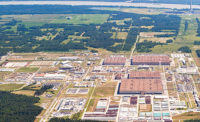On the job, do you know that your gas monitors will protect your teams? Do you have the right tools to properly monitor both your people and process? With so many options on the market, it can be difficult to find the perfect gas detector to fit your unique needs — and it only gets more difficult when you need to consider both personal monitoring and process monitoring equipment.
Getting the right gas monitor for the job doesn’t need to be a cumbersome task, however; particularly as recent advancements in technology have helped to create some of the most compact, versatile, and connected personal monitors (which can also be used for process monitoring by detecting VOCs) available today.
A look at monitoring equipment
Across nearly every industrial site, many people use personal gas monitors to protect themselves and their teams from toxic and combustible gases. At the same time, there are personal monitors that can be used as a process monitoring tool by continuously reading the concentrations of toxic and combustible gases surrounding the user while they complete their task.
Most of the time personal gas monitors have different sensor configurations than a process monitor, as they’re used in different applications. For example, personal monitors with a standard four-gas configuration (O2, LEL, H2S, and CO) are typically worn on the body, whereas a process instrument can be configured for a more robust range of gases — including Cl2, ClO2, HCl, NH3, PH3, and volatile organic compounds (VOCs) — with a pump and tubing.
However, just like every other electronic device we use in our lives, handheld gas monitors are becoming smaller, lighter, easier to use, and now feature the latest technological advancements in the industry.
Challenges faced today
While using both process and personal gas monitoring equipment, there are a variety of challenges that users face that can cause unnecessary downtime, the inability to gather data, and more.
One common issue that users can face when using both personal and process gas monitoring equipment is training, as process instruments could be a different type of gas detector or are only authorized to be used at specific times by qualified individuals — which can cause downtime if a particular individual isn’t available. Personal monitors, on the other hand, can be used by every individual working at the site daily.
Additionally, understanding the day-to-day operations of any given worker who uses gas monitoring equipment can be both frustrating and cumbersome, especially if you’re receiving varying responses from multiple qualified individuals. In an ideal world, understanding the functionality of each user and how they’re using each piece of equipment and its respective technology would be an easy task; but for many individuals, they’re fulfilling multiple on-site duties, with gas detection taking up a sliver of their responsibilities.
On a more granular level, detecting VOCs is often a critical need across chemical plants, fire and hazmat response teams, and downstream oil and gas refiners, among many other places. Unfortunately, there are limited multi-gas personal monitoring options that can be easily worn within an individual’s breathing zone to detect VOCs. Today, most of the solutions are bulky, handheld process monitors that are used in additional to personal monitors to perform sampling and survey work.
These large monitors are also often from different manufacturers — resulting in your gas detection data being in different systems and locations, as well as making it more difficult for safety personnel to get a full picture of any hazards.
Combining personal and process monitoring
While handheld gas monitors continue to replicate other electronic devices in our lives, the latest advancements in gas detection technology allow personal gas monitors and process monitoring equipment to be streamlined into one device — helping to simplify trainings, minimize the amount of equipment required to perform a task, and overall increase efficiency.
For example, some gas monitors available today now feature a Photo Ionization Detector (PID) so users can detect VOCs all with one, compact personal monitor. With these enhancements, these sensors can be configured for process-related tasks that require sensors capable of detecting gases such as CL2, SO2, HCN, NO2, PH3, and NH3, as well as VOCs — reducing the need for additional bulky handheld monitors. By limiting the need for supplementary devices, users can also help reduce fleet sizes and maintenance pains.
Even with these technological upgrades, the same instrument can still be configured to meet the requirements of any industry for personal gas monitors, including in a wide range of confined space applications. Regardless of use case, an on-board suite of wireless technologies can be utilized to enhance user experience and create a safer work environment.
If a sensor does feature these wireless technologies — such as peer-to-peer, satellite, wi-fi, or cellular connectivity options — users’ personal gas monitors can help to increase situational awareness and decrease emergency response times by sharing real-time location data, man-down alarms, and gas alerts (including VOC exposure), so your safety teams know immediately who needs help, what happened, and where they’re located.
When you rely on personal gas monitors and process monitors to complete daily tasks, you need to be certain that the equipment you are using is going to keep you safe on the job. Hazards vary from industry to industry, but safety, training, and data collection should remain consistent. You need the right equipment, and the choice is an important one to make: it ultimately comes down to finding the right set of features in a gas monitor that will best serve your needs and keep you and your teams safe.


